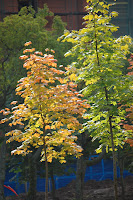Once upon an early eighteenth century, the man in charge decided that a mosquito-infested swamp would be a terrific place to build a new fort. It wasn’t the little vampires with the long, blood-sucking proboscises that enthralled him when he chose the place, but instead the site’s advantageous location adjacent to the
Here, he thought, would be the best place to keep those marauding Swedes out of his country, no matter that the Swedes had held this territory for a few decades. This spot would provide
Thus was founded a city that became known as  eter was enamored of all things European, and often traveling incognito through the countries and soaking up Western culture. Deciding that his city would be fashioned after the great cities of
eter was enamored of all things European, and often traveling incognito through the countries and soaking up Western culture. Deciding that his city would be fashioned after the great cities of
Three months later, wind and atmospheric pressure combined to create a phenomenon known as a “long wave.” Though the citadel was being built three miles inland, the long wave rolled in from the Baltic Sea, through the Gulf of Finland to the shallow Neva River Bay, and up the Neva River, where it inundated the construction site with six feet of water, washing away much of the building material.
Tsar Peter was said to be six feet eight inches tall, a huge man for his day. His head, however, was far too small in proportion to his massive body, and perhaps that had something to do with Peter ordering the construction to recommence. Thus began
 The Peter and Paul Fortress with the bell tower spire, middle, and cathedral dome at left.
The Peter and Paul Fortress with the bell tower spire, middle, and cathedral dome at left.
In 1713, Tsar Peter I moved the capital of
Eventually the growing city covered a hundred and one islands in the braided delta of the

The Neva begins at

Our tour group approached


Eventually we tied up near the newest bridge in the city, and its first suspension bridge.

The first day in

Upper portion of Smolny Cathedral

A couple of those long-legged Russian women
 All the buildings are equipped with six inch rain drains.
All the buildings are equipped with six inch rain drains.

The upper domes of the Church of the Savior on Blood, which marks the spot where Emperor Alexander II received mortal wounds from a bomb thrown by a terrorist.
 The two Rostrums, which were once lighthouses, outside the former Stock Exchange building on the right, now a Naval museum. The spire of the Peter and Paul bell tower is in the background
The two Rostrums, which were once lighthouses, outside the former Stock Exchange building on the right, now a Naval museum. The spire of the Peter and Paul bell tower is in the background
By the time we concluded our first day’s tour, the clouds were parting and the rest of our stay was in warm, bright sunshine.

The Church of the Savior on Blood

Lamppost near the church. I have no idea what the padlocks symbolize, and neither did the tour guide
 The base of the lamppost.
The base of the lamppost.

The Smolny Cathedral on a nice day

Air foils are used extensively for commuting

A woman sowing and raking grass seed into the re-landscaped grounds of a nearby church

...and pigeons feasting on the new grass seed

a familiar sight

fountains downtown

curbside kiosk

the “non-nuclear” nuclear cooling towers. We were told they are used by gas generators.

the famous Hermitage museum

an infamous prison, now closed and undergoing remodeling into a hotel and entertainment center

curtain tie back on our tour coach

autumn trees
You've created an extremely interesting post, Gully. If I keep hanging out here, I'll become an educated woman.
ReplyDeleteI especially like the rainy day photo of Smolny Cathedral. I'm going to go get Sarah and bring her to see it. It'll blow her mind.
I've recently run across your posts and am enjoying them and the photographs so very much. Thank you for sharing.
ReplyDeleteFYI, I googled the locks on the lampost and came up with a post explaining them...very romantic, here is the first paragraph of the post and a link for further reading. "Locks of love are the padlocks fixed by loving couples, on to a fence or a pole or metallic chain/string alongside some wall etc at a public place, to symbolize their eternal love. A couple would hang a padlock after inscribing their name or initials on it and throw the key away so that their love is locked forever. Some couple use two inter-twined locks, each lock bearing their name/initials. Besides lovers, often family members and close friends also put such locks at these places, to lock their relationship forever."
http://bbs.keyhole.com/ubb/ubbthreads.php?ubb=showflat&Number=1260732&site_id=1#import
The trip is drawing to a close. Cap and Patti
ReplyDelete